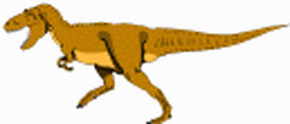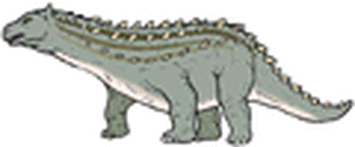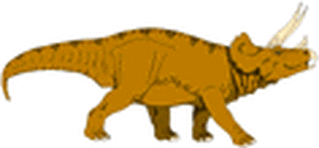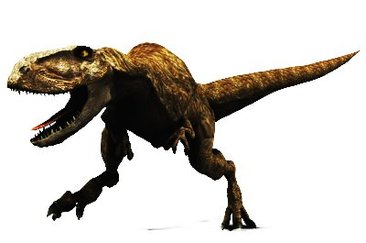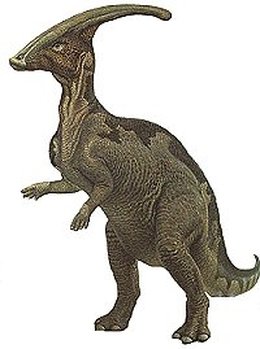Age of the reptiles
The Mesozoic Era is a period from about 250 million years ago to about 67 million years ago. It is called the Age of Dinosaurs because most dinosaurs developed, and went extinct, during that time.
The Mesozoic is divided into three time periods: the Triassic (245-208 Million Years Ago), the Jurassic (208-146 Million Years Ago), and the Cretaceous (146-65 Million Years Ago).
Dinosaurs, which are perhaps the most popular organisms of the Mesozoic, evolved in the Triassic, but were not very diverse until the Jurassic. Except for birds, dinosaurs became extinct at the end of the Cretaceous. Some of the last dinosaurs to have lived are found in the late Cretaceous deposits of Montana in the United States.
The Mesozoic was also a time of great change in the terrestrial vegetation. The early Mesozoic was dominated by ferns, cycads, ginkgophytes, bennettitaleans, and other unusual plants. Modern gymnosperms, such as conifers, first appeared in their current recognizable forms in the early Triassic. By the middle of the Cretaceous, the earliest angiosperms had appeared and began to diversify, largely taking over from the other plant groups.
The Triassic Period
248 to 206 Million Years Ago
The Triassic was a time of transition. It was at this time that the world-continent of Pangaea existed, altering global climate and ocean circulation. The Triassic also follows the largest extinction event in the history of life, and so is a time when the survivors of that event spread and recolonized.
The organisms of the Triassic can be considered to belong to one of three groups: holdovers from the Permo-Triassic extinction, new groups which flourished briefly, and new groups which went on to dominate the Mesozoic world. The holdovers included the lycophytes, glossopterids, and dicynodonts. While those that went on to dominate the Mesozoic world include modern conifers, cycadeoids, and the dinosaurs.
248 to 206 Million Years Ago
The Triassic was a time of transition. It was at this time that the world-continent of Pangaea existed, altering global climate and ocean circulation. The Triassic also follows the largest extinction event in the history of life, and so is a time when the survivors of that event spread and recolonized.
The organisms of the Triassic can be considered to belong to one of three groups: holdovers from the Permo-Triassic extinction, new groups which flourished briefly, and new groups which went on to dominate the Mesozoic world. The holdovers included the lycophytes, glossopterids, and dicynodonts. While those that went on to dominate the Mesozoic world include modern conifers, cycadeoids, and the dinosaurs.
The Jurassic Period
206 to 144 Million Years Ago
Great plant-eating dinosaurs roaming the earth, feeding on lush growths of ferns and palm-like cycads and bennettitaleans. . . smaller but vicious carnivores stalking the great herbivores. . . oceans full of fish, squid, and coiled ammonites, plus great ichthyosaurs and long-necked plesiosaurs. . . vertebrates taking to the air, like the pterosaurs and the first birds. . . this was the Jurassic Period, beginning approximately 210 million years ago and lasting for 70 million years of the Mesozoic Era.
Named for the Jura Mountains on the border between France and Switzerland, where rocks of this age were first studied, the Jurassic has become a household word with the success of the movie Jurassic Park. Outside of Hollywood, the Jurassic is still important to us today, both because of its wealth of fossils and because of its economic importance -- the oilfields of the North Sea, for instance, are Jurassic in age.
206 to 144 Million Years Ago
Great plant-eating dinosaurs roaming the earth, feeding on lush growths of ferns and palm-like cycads and bennettitaleans. . . smaller but vicious carnivores stalking the great herbivores. . . oceans full of fish, squid, and coiled ammonites, plus great ichthyosaurs and long-necked plesiosaurs. . . vertebrates taking to the air, like the pterosaurs and the first birds. . . this was the Jurassic Period, beginning approximately 210 million years ago and lasting for 70 million years of the Mesozoic Era.
Named for the Jura Mountains on the border between France and Switzerland, where rocks of this age were first studied, the Jurassic has become a household word with the success of the movie Jurassic Park. Outside of Hollywood, the Jurassic is still important to us today, both because of its wealth of fossils and because of its economic importance -- the oilfields of the North Sea, for instance, are Jurassic in age.
The Cretaceous Period
144 to 65 Million Years Ago
The Cretaceous is usually noted for being the last portion of the "Age of Dinosaurs", but that does not mean that new kinds of dinosaurs did not appear then. It is during the Cretaceous that the first ceratopsian and pachycepalosaurid dinosaurs appeared. Also during this time, we find the first fossils of many insect groups, modern mammal and bird groups, and the first flowering plants.
The breakup of the world-continent Pangaea, which began to disperse during the Jurassic, continued. This led to increased regional differences in floras and faunas between the northern and southern continents.
The end of the Cretaceous brought the end of many previously successful and diverse groups of organisms, such as non-avian dinosaurs and ammonites. This laid open the stage for those groups which had previously taken secondary roles to come to the forefront. The Cretaceous was thus the time in which life as it now exists on Earth came together.
Climate The Triassic was generally dry, a trend that began in the late Carboniferous, and highly seasonal, especially in the interior of Pangaea. Low sea levels may have also exacerbated temperature extremes. With its high specific heat capacity, water acts as a temperature-stabilizing heat reservoir, and land areas near large bodies of water—especially the oceans—experience less variation in temperature. Because much of the land that constituted Pangaea was distant from the oceans, temperatures fluctuated greatly, and the interior of Pangaea probably included expansive areas of desert. Abundant evidence of red beds and evaporites such as salt support these conclusions.
Sea levels began to rise during the Jurassic, which was probably caused by an increase in seafloor spreading. The formation of new crust beneath the surface displaced ocean waters by as much as 200 m (656 ft) more than today, which flooded coastal areas. Furthermore, Pangaea began to rift into smaller divisions, bringing more land area in contact with the ocean by forming the Tethys Sea. Temperatures continued to increase and began to stabilize. Humidity also increased with the proximity of water, and deserts retreated.
The climate of the Cretaceous is less certain and more widely disputed. Higher levels of carbon dioxide in the atmosphere are thought to have caused the world temperature gradient from north to south to become almost flat: temperatures were about the same across the planet. Average temperatures were also higher than today by about 10°C. In fact, by the middle Cretaceous, equatorial ocean waters (perhaps as warm as 20°C in the deep ocean) may have been too warm for sea life, and land areas near the equator may have been deserts despite their proximity to water. The circulation of oxygen to the deep ocean may also have been disrupted. For this reason, large volumes of organic matter that was unable to decompose accumulated, eventually being deposited as "black shale".
Not all of the data support these hypotheses, however. Even with the overall warmth, temperature fluctuations should have been sufficient for the presence of polar ice caps and glaciers, but there is no evidence of either. Quantitative models have also been unable to recreate the flatness of the Cretaceous temperature gradient.
Oxygen levels in the Mesozoic atmosphere were probably lower (12 to 15%) than today's level (20 to 21%). Some researchers have postulated levels of 12% because that was assumed to be the lowest concentration at which natural combustion could occur. However, a 2008 study concludes that at least 15 % is necessary.
144 to 65 Million Years Ago
The Cretaceous is usually noted for being the last portion of the "Age of Dinosaurs", but that does not mean that new kinds of dinosaurs did not appear then. It is during the Cretaceous that the first ceratopsian and pachycepalosaurid dinosaurs appeared. Also during this time, we find the first fossils of many insect groups, modern mammal and bird groups, and the first flowering plants.
The breakup of the world-continent Pangaea, which began to disperse during the Jurassic, continued. This led to increased regional differences in floras and faunas between the northern and southern continents.
The end of the Cretaceous brought the end of many previously successful and diverse groups of organisms, such as non-avian dinosaurs and ammonites. This laid open the stage for those groups which had previously taken secondary roles to come to the forefront. The Cretaceous was thus the time in which life as it now exists on Earth came together.
Climate The Triassic was generally dry, a trend that began in the late Carboniferous, and highly seasonal, especially in the interior of Pangaea. Low sea levels may have also exacerbated temperature extremes. With its high specific heat capacity, water acts as a temperature-stabilizing heat reservoir, and land areas near large bodies of water—especially the oceans—experience less variation in temperature. Because much of the land that constituted Pangaea was distant from the oceans, temperatures fluctuated greatly, and the interior of Pangaea probably included expansive areas of desert. Abundant evidence of red beds and evaporites such as salt support these conclusions.
Sea levels began to rise during the Jurassic, which was probably caused by an increase in seafloor spreading. The formation of new crust beneath the surface displaced ocean waters by as much as 200 m (656 ft) more than today, which flooded coastal areas. Furthermore, Pangaea began to rift into smaller divisions, bringing more land area in contact with the ocean by forming the Tethys Sea. Temperatures continued to increase and began to stabilize. Humidity also increased with the proximity of water, and deserts retreated.
The climate of the Cretaceous is less certain and more widely disputed. Higher levels of carbon dioxide in the atmosphere are thought to have caused the world temperature gradient from north to south to become almost flat: temperatures were about the same across the planet. Average temperatures were also higher than today by about 10°C. In fact, by the middle Cretaceous, equatorial ocean waters (perhaps as warm as 20°C in the deep ocean) may have been too warm for sea life, and land areas near the equator may have been deserts despite their proximity to water. The circulation of oxygen to the deep ocean may also have been disrupted. For this reason, large volumes of organic matter that was unable to decompose accumulated, eventually being deposited as "black shale".
Not all of the data support these hypotheses, however. Even with the overall warmth, temperature fluctuations should have been sufficient for the presence of polar ice caps and glaciers, but there is no evidence of either. Quantitative models have also been unable to recreate the flatness of the Cretaceous temperature gradient.
Oxygen levels in the Mesozoic atmosphere were probably lower (12 to 15%) than today's level (20 to 21%). Some researchers have postulated levels of 12% because that was assumed to be the lowest concentration at which natural combustion could occur. However, a 2008 study concludes that at least 15 % is necessary.
Ornithischia:
A major group in this order was the Ornithopods. These were mostly bipeds at first, like Iguanodon. Iguanodon had large spikes instead of thumbs, probably used for defense or foraging. All Ornithopods (and all Ornithischia) were herbivores. [Heterodontosaurus, Lycorhinus, Camptosaurus, Iguanodon] The early Ornithopods evelved into two groups:
The Hadrosaurs lived during the late Cretaceous. These have been given the nickname "duck bills" because of their mysteriously shaped mouths. They looked like flat, toothless beaks. But what was even more interesting was the rest of the head. It had a crest, which was a long nose-bone, sticking out on top of the head. Several different shapes and sizes of these crests existed. Scientists are puzzled by the use of these. Samples of Hadrosaurs have even come with intact skin, so we know almost exactly how they looked like. [Anatosaurrus, Lambeosaurus, Saurolophus, Parasaurolophus, Corythosaurus]
Ceratopians, or horned dinosaurs, also evolved from the Ornithopods. This group contains another very famous dinosaur - Triceratops. Triceratops had three horns on its head and a bony ruffle covering its neck. These Ceratopians are much like the modern Rhinoceros - big and powerful with a horn on top. The largest Ceratopians weighed 8 tons, but the smaller ones, like Protoceratops, were not quite so grand. [Protoceratops, Triceratops, Chasmosaurus, Monoclonius, Styracosaurus]
Another Ornithischia group was the Stegosaurus. Needing to adapt because of its lack of speed, the famous Stegosaur Stegosaurus developed large spikes on its tail and upright armor plates on its back. Even with this display of defense, the Stegosaurs died out by the end of the Jurassic [Stegosaurus]
Ankylosaurs were the tanks of the Cretaceous. On their tails, they had large clubs or spikes to defend themselves. On their backs, they had armor, spikes, and hard leathery skin. [Ankylosaurus]
A major group in this order was the Ornithopods. These were mostly bipeds at first, like Iguanodon. Iguanodon had large spikes instead of thumbs, probably used for defense or foraging. All Ornithopods (and all Ornithischia) were herbivores. [Heterodontosaurus, Lycorhinus, Camptosaurus, Iguanodon] The early Ornithopods evelved into two groups:
The Hadrosaurs lived during the late Cretaceous. These have been given the nickname "duck bills" because of their mysteriously shaped mouths. They looked like flat, toothless beaks. But what was even more interesting was the rest of the head. It had a crest, which was a long nose-bone, sticking out on top of the head. Several different shapes and sizes of these crests existed. Scientists are puzzled by the use of these. Samples of Hadrosaurs have even come with intact skin, so we know almost exactly how they looked like. [Anatosaurrus, Lambeosaurus, Saurolophus, Parasaurolophus, Corythosaurus]
Ceratopians, or horned dinosaurs, also evolved from the Ornithopods. This group contains another very famous dinosaur - Triceratops. Triceratops had three horns on its head and a bony ruffle covering its neck. These Ceratopians are much like the modern Rhinoceros - big and powerful with a horn on top. The largest Ceratopians weighed 8 tons, but the smaller ones, like Protoceratops, were not quite so grand. [Protoceratops, Triceratops, Chasmosaurus, Monoclonius, Styracosaurus]
Another Ornithischia group was the Stegosaurus. Needing to adapt because of its lack of speed, the famous Stegosaur Stegosaurus developed large spikes on its tail and upright armor plates on its back. Even with this display of defense, the Stegosaurs died out by the end of the Jurassic [Stegosaurus]
Ankylosaurs were the tanks of the Cretaceous. On their tails, they had large clubs or spikes to defend themselves. On their backs, they had armor, spikes, and hard leathery skin. [Ankylosaurus]
For whatever reason, dinosaurs died out at the end of the Cretaceous. Although no one knows yet why this happened, the general scientific populace supports the theory that there was a climate change on earth that the creatures could not adapt to. It is a mystery, though, how this occurred.
The most supported theory is that of a large meteor hitting the earth, spewing dust and debris into the air. This would block sunlight, causing a cooling in the earth's climate. In turn, cold-blooded animals would die out. In recent years, scientists have found a possible crash site off the Yucatan Peninsula in Mexico.
Another climatic change theory is one where volcanoes spit out a lot of dust, also blocking the sun.
The most supported theory is that of a large meteor hitting the earth, spewing dust and debris into the air. This would block sunlight, causing a cooling in the earth's climate. In turn, cold-blooded animals would die out. In recent years, scientists have found a possible crash site off the Yucatan Peninsula in Mexico.
Another climatic change theory is one where volcanoes spit out a lot of dust, also blocking the sun.
